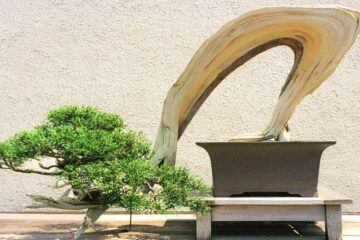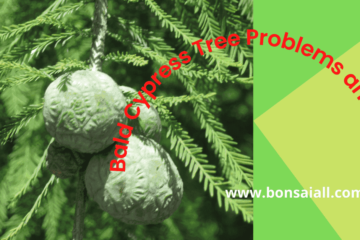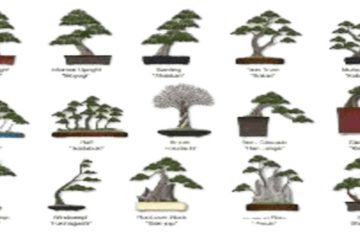Looking to start growing some beautiful trees outdoors? Then you’ll want to read this beginner’s guide to caring for outdoor bonsai trees. We’ll teach you the basics of how to water, fertilize, and prune your trees so that they can grow into beautiful and healthy specimens. This guide is for anyone who wants to learn more about gardening!
What is a Bonsai Tree?
Content Overview
A bonsai tree is a miniature tree that is cultivated in a pot. Bonsai trees are often shaped and pruned to look like full-size trees. Bonsai trees can be made from many different kinds of trees, including fruit trees, flowering trees, and evergreen trees.
Bonsai trees are native to Asia. Over the last 1,000 years, they’ve been planted throughout China. In the 12th century, bonsai trees were first introduced to Japan.. Bonsai trees became popular in Europe and North America in the 20th century.
Bonsai trees are not easy to care for. They require patience and care. Bonsai tree care can be divided into four main parts: watering, pruning, fertilizing, and repotting.
Watering: Bonsai trees should be watered on a regular basis. The frequency of watering will depend on the type of tree, the size of the pot, the climate, and other factors. Overwatering can kill a bonsai tree and learn how to revive your bonsai tree?
Pruning: Bonsai trees need to be pruned regularly to keep them small and to shape them. New growth is also assisted by pruning.
Types of Bonsai Trees
There are many various types of bonsai trees. Some common types include the following:
Ficus: Ficus bonsai trees are a popular choice for beginners. They have a high tolerance for mistakes and are easy to care for. Ficus bonsai trees can be found in many different shapes and sizes.
Juniper: Juniper, Jade bonsai tree, and bonsai trees are good choices for those who want a more traditional bonsai tree. They are fairly simple to take care of, although they demand a little more care than other types of bonsai trees. Juniper bonsai trees can be found in many different shapes and sizes.
Bald Cypress: Bald cypress bonsai trees are a good choice for those who live in climates humidity. They have a high tolerance for mistakes and are relatively easy to care for. There are several different forms and sizes of bald cypress bonsai trees.
Overall, there are many different types of bonsai trees to choose from. Beginners should start with a type that is easy to care for, such as a ficus or juniper, Japanese maple, or Chinese Elm.
How do take care of your outdoor bonsai trees?
Outdoor bonsai trees are delicate and require special care. Guidelines on how to care for your outdoor bonsai trees are as follows:
1) Are you ready to create your first outdoor bonsai?
Outdoor bonsai trees are easy to care for, but there are a few basic things you should know before you dive in. If you’re interested in getting started with your own outdoor bonsai tree but aren’t sure where to begin, we have 10 tips that will get you on your way.
From what type of outdoor bonsai tree to buy, to proper outdoor bonsai tree care, these tips will help you keep your outdoor bonsai happy and healthy for years to come.
2) The Five Elements Theory – A Guide To Bonsai Tree Styles
People have long enjoyed bonsai trees, but there are many different ways to enjoy them. You can take pride in your miniature tree, use it as a hobby or even try your hand at selling trees if you get really into it.
The most basic distinction between types of bonsai trees is whether they are grown indoors or outdoors. Outdoor bonsai care is very different from indoor growing, so be sure to read up on outdoor bonsai trees care before attempting an outdoor planting.
The Five Elements Theory – A Guide To Bonsai Tree Styles: Most people don’t realize that there is actually a theory behind their favorite art form. But, just like any other art form, bonsai has a set of rules that govern its design.
In fact, these rules are known as The Five Elements Theory, and understanding them will help you create better-looking bonsais.
The Five Elements Theory is based on traditional Chinese philosophy, which holds that all things in nature can be defined by five elements: water, light, earth, metal, and wood. Combining these elements will help you create a harmonious bonsai design that takes your tree from boring to breathtaking.
3) The Training Process For Your First Outdoor Bonsai Trees
It’s very important to learn as much as you can about bonsai trees prior to getting your first one. The training process is fairly straightforward, but each tree is a little different, so it’s important to read up on any particular variety you’re interested in.
Because bonsai trees are living organisms, there will always be a certain amount of trial-and-error involved; that said, some species are easier than others when it comes to care and maintenance.
In any case, if you’re new to bonsai, it’s important to start small. You want to work with a tree that has a reasonable amount of time left in its training process before reaching maturity—in other words, don’t choose a hundred-year-old juniper as your first.
For instance, it’s possible to grow a rather large bonsai from a tiny cutting in as little as two years; at two years old, you can then replant it in its permanent home. In outdoor circumstances, there are several species that flourish. If you’re new to bonsai, it’s important to start small—don’t choose a hundred-year-old juniper as your first tree!
4) Planting Your First Outdoor Bonsai
If you’re just starting out with bonsai trees, it’s important to remember that what makes a great indoor tree doesn’t necessarily make a great outdoor tree.
While there are some trees that can be easily transitioned from indoors to outdoors (like maples), others will struggle outside or won’t thrive without specific care.
Regardless of whether you have indoor or outdoor bonsai trees, however, there are certain steps you should take for proper care and maintenance.
When caring for your outdoor bonsai tree, it’s important to keep in mind that they live in a very different environment than indoor trees.
They are subjected to much harsher conditions like extremes in temperature, harsh sunlight, pests, wind, hail, and drought.
You will have to take extra procedures when caring for your tree due to these reasons. Following these 10 tips will help keep your tree healthy so it can grow into a beautiful specimen.
5) Soil Matters – Choosing the Right Soil For Your Tree
The type of bonsai soil you use is vitally important to your bonsai tree’s health. There are two main types: organic and inorganic. Organic soils are made from bark, peat moss, charcoal, sand, or sawdust mixed with a bit of manure.
The best mixture contains one part sand, two parts peat moss, and three parts forest humus; if you can’t find forest humus, add an equal amount of topsoil.
On top of that, if you live in a region with alkaline soil, you’ll need to use pine bark or sphagnum moss to adjust its pH. Inorganic soils are made from perlite, vermiculite, or gravel. These are better suited for bonsai trees which are planted in pots than those grown in garden beds. You’ll need calcined clay if you live in an acidic soil region.
6) Water And Fertilizers For Your First Bonsai Tree
When you have a new bonsai tree, one of your priorities should be making sure it stays healthy. This will entail regular watering along with periodic use of fertilizers. Here are some tips on both.
Watering your tree is an integral part of how to care for bonsai trees. Taking care of your bonsai is one of the most important things you do.
In order to prevent root rot, over-watering should be avoided. Fertilizing your bonsai tree should also be done periodically but you must use fertilizer sparingly.
7) Understanding Sunlight And Wind Exposure On Urban Landscapes
While bonsai trees are commonly known as indoor bonsai plants, they can actually be grown outdoors in temperate regions.
However, bonsai trees should not be exposed to direct sunlight or strong winds because they may burn or topple over due to excessive heat and extreme weather conditions.
The best place to keep an outdoor bonsai tree is under a small canopy or large shade tree, ideally planted near a body of water to protect it from drying out.
8) Repotting Techniques For Indoor And Outdoor Plants
Keeping your bonsai trees healthy is crucial. When they grow too big, you’ll need to repotting them.
Whether they’re indoor or outdoor plants, repotting your bonsai tree will allow it to continue growing strong.
It can be intimidating at first, but once you try it once or twice, you’ll find that it’s not all that difficult—and you may even look forward to doing it again!
Read More : How to Repot a Bonsai for Beginners
9) Pests And Diseases – Issues That Can Affect Any Plant
If you have outdoor bonsai trees, they’re at risk from insects, mold, mildew, fungi, and other pests that can damage or kill them. It is important to regularly check your plants for signs of disease or infestation so you can take care of them before things get out of hand.
Here are some signs to look out for The appearance of a powdery white substance on leaves or needles: This could be a sign of powdery mildew, which is caused by a fungus.
To treat it, spray affected areas with water mixed with baking soda (1 teaspoon per gallon) twice a week until all symptoms disappear.
10)Trimming Your Outdoor Bonsai Trees
Trimming your bonsai tree is a very important step in the care of your Bonsai. By trimming, you will be able to ensure that the branches and leaves are all healthy and beautiful.
You can trim them any time you want, but it is best to do so after they have grown for at least one year or more. Trimming your bonsai tree can be done in different ways:
1) With a saw.
If you have access to a saw, you can use it to cut the branches off of your bonsai tree. Make sure that you are careful not to cut too much because this could damage the wood.
2) With scissors or shears.
You can also use scissors or shears to clip away the branches from your bonsai tree. Just be sure to cut at an angle so the ends of the branch will grow more evenly and get healthier.
3) Web Shear
A web shear is designed for trimming trees into precision cuts, with a rubberized cutting blade that glides easily in one direction whilst protecting you against germination damage, etc.
Make sure your tree is well-rooted before selecting this approach.
Read More: The Ultimate Guides on How to Trim a Japanese Maple
11)When to Prune Trees and Shrubs
Remember that even though you may be dealing with small plant sizes, it is still alive!
Shrubs and shrubbery are among the most popular choices for plantings in many areas of the country.
As with any other plant, shrubbery requires some care to thrive and grow well. Most shrub trees or shrubs need regular pruning so that they remain healthy and look attractive as they mature. When you prune your bonsai tree,
- Keep the overall shape of the shrub consistent.
- Clip off any branches that are growing out of the desired shape or size, and grow too far beyond their allotted boundaries.
- Prune back unhealthy or diseased branches to a healthy length and remove all dead or damaged wood.
12)When to Pruning Your Outdoor Bonsai Trees
There are three general categories of trees: deciduous, evergreen, and coniferous. You should prune your tree according to the type of tree it is.
Deciduous Trees –
In the autumn, deciduous trees shed their leaves, and in the spring, new foliage emerges. You should generally prune these trees in late winter or early spring after all of the leaves have dropped off. Make sure to remove any diseased or broken branches and foliage.
Evergreen Trees –
Evergreen trees retain their leaves all year long. You should usually trim these trees in late winter or early spring before new growth appears. Make sure to remove any diseased or broken branches and foliage.
Coniferous Trees –
Coniferous tree leaves are needle-like structures that do not drop off when falling. In order for your tree to grow, you must prune before the new growth begins to make room for new branches and foliage.
You can generally conduct these cuts any time after about 20% of the needles have dropped off because this is approximately 10″ above soil level or when there is ¼” more exposed wood on each side than there was original.
How to Prepare your Bonsai for the Winter
If you live in an area where the winters are cold, you will need to take some special care of your bonsai tree. Bonsai trees are native to countries with milder climates, so they are not used to surviving in freezing temperatures.
However, with a little bit of preparation, your bonsai can make it through the winter without any problems.
One of the most important things you can do to prepare for winter is to scale back your bonsai’s watering schedule.
During the winter, the ground is frozen and there is less sunlight, so your bonsai will not need as much water. By putting your bonsai in a sheltered area, you should also keep it safe from the wind.
And finally, you may want to consider covering your bonsai with a light cloth or plastic sheeting to protect it from the coldest temperatures.
By using these procedures you may aid your bonsai through the winter and bloom in the spring.
Caring for Your Outdoor Bonsai trees in the Spring and Summer
Outdoor bonsai trees need special care during the spring and summer months. The most essential thing to keep in mind when growing bonsai is that they should never become too dry.
Water your bonsai every two to three weeks, keeping the soil moist but not soggy.
You’ll need to fertilize your bonsai more often throughout the warmer months. Bonsai fertilizers made for this purpose may be used. Follow the steps precisely as they’re written on the box.
It is also important to protect your bonsai from excessive heat and direct sunlight. Always place your bonsai in a shady spot during the hottest days of summer. If possible, move it indoors or into a greenhouse if temperatures become too extreme.
You can ensure that your bonsai trees for outdoor stay healthy and happy all summer long by following these simple tips!
How to Care for Your Outdoor Bonsai trees in Autumn
As the weather begins to cool down in autumn, you’ll need to take some special care of your outdoor bonsai trees. Here are a few tips:
- Water your bonsais regularly, as the cooler temperatures will cause the soil to dry out more quickly.
- Protect your bonsais from frost by moving them indoors or into a greenhouse at night.
- If you live in an area with particularly cold winters, you may need to wrap your bonsais in burlap or other fabric to protect them from the elements.
- To keep your bonsais healthy throughout the winter, fertilize them every few weeks.
You can keep your outdoor bonsais healthy and beautiful all fall long by following these simple guidelines.
What Kind Of Tools Do I Need To Grow My Own Garden?
Besides a garden, you’ll need some gardening tools. You’re probably familiar with the standard rake, hoe, spade, and trowel. Don’t be concerned if it’s not the case. There are also other types of tools that will make your life easier when it comes to growing your own garden. Here are just a few
(1) Garden gloves – These will make your hands grateful!
(2) Wheelbarrow – It can be hard work lugging around bags of soil or mulch from one place to another. A wheelbarrow makes moving these items much easier.
(3) Watering can – This is great if you have a lot of plants in one area or if you want to water them on a regular basis without having to go back and forth with buckets all day long.
(4) Shovel – You’ll need a shovel to dig holes for planting as well as digging up weeds.
(5) Hose – If you plan on watering your garden regularly, using a hose will save you time and energy over using buckets. Just let the tap run when you’re ready!
Read More: Bonsai Clippers Vs Bonsai Scissors -Which Is Best For Trimming Your Bonsai Tree and Why?
Conclusion
Now that you know the basics of bonsai care, you’re ready to get started on your own outdoor bonsai journey! Remember to check on your tree’s health every now and again, and if you encounter any difficulties, contact a professional. With a little patience and care, you’ll be able to enjoy your very own beautiful bonsai for many years to come.



